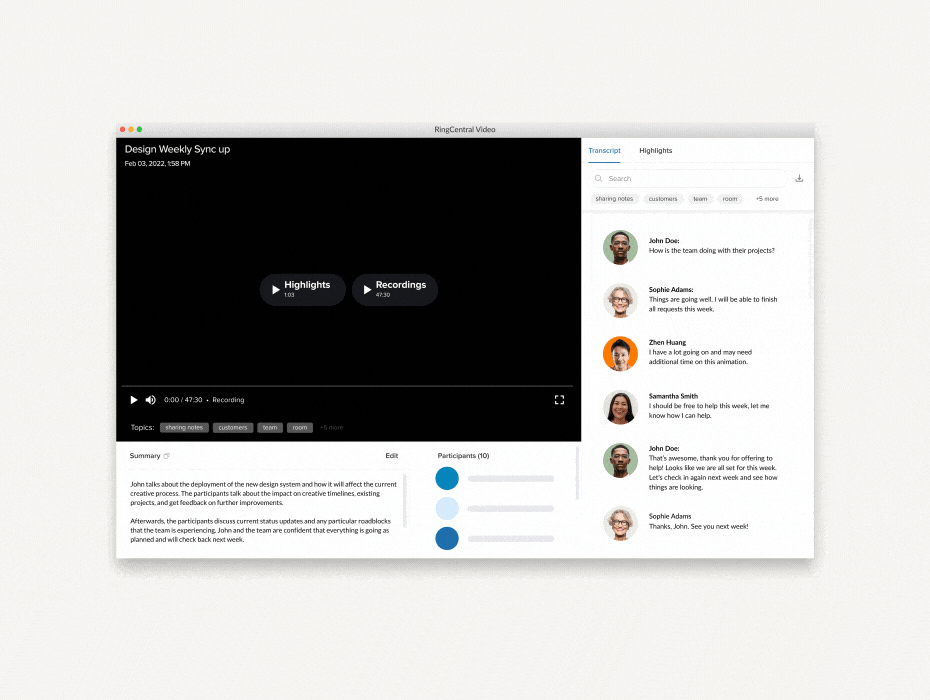Simpler communications. It’s the idea that whether you connect on phone, video, messaging, or contact center, you have everything you need to supercharge your productivity—from anywhere and on any device.
And in today’s world, simpler communications also mean taming app overload, combating video fatigue, resolving customer issues faster, and automating the menial tasks of your everyday work.
That being said, we’re excited to announce a new wave of innovations that will help you thrive in the hybrid workplace. Here are some new feature highlights from Q2 2022:
Advanced calling capabilities that reduce IT burden
We’re delivering new cloud business phone capabilities that reduce critical IT burdens and deliver significant time and cost savings.
1. Auto Dialer
Call specific pre-programmed numbers as soon as your phone is taken off the hook. Auto dialers are great for use cases such as automatically dialing your security office or an emergency response team.
Within other service-oriented contexts, it could be used to automatically dial a concierge or the front desk. IT can expedite services by pre-programming numbers for phones to automatically make calls instantly, without having to memorize or manually dial phone numbers.
2. Line seizure for emergency services
Allows IT to lock down all the lines within particular sites so users can only make and receive calls to/from a phone number designated by emergency services.

3. Bulk uploading of new users
Save time and effort when updating Admin Portal settings, user roles, and templates after upload.
Our new streamlined process allows IT admins to add new users in bulk via a more intuitive user interface (UI), additional columns for bulk information import, and better error handling and feedback mechanisms.
4. A new Resource Center to enhance self-service onboarding

The Resource Center on desktop and mobile has been enhanced with additional pages, along with a new look and feel.
Users can more easily and impactfully discover features in the RingCentral app to help them get started, enhance their experience with suggested and new features, get support, and submit feedback.
Unlocking new business efficiencies across business communications
5. Collaborative whiteboard across mobile and desktop

RingCentral Whiteboard provides a rich collaborative experience for hybrid teams—no matter where they work from.
The new Whiteboard allows you to draw, upload files, and brainstorm ideas on a near-infinite digital canvas. It also includes powerful unique capabilities such as a “Bring everyone to me” button and minimap to easily find people and jump to specific areas on the canvas.
Whiteboard will be available in June 2022.
6. Instantly forward all calls
Users can instantly forward all incoming calls with a single click within the RingCentral app. This feature is available on both RingCentral desktop and mobile apps.
Whether going on a break or vacation, incoming calls can be forwarded to a recording, voicemail, a co-worker, call queue, shared line, Interactive Voice Response (IVR), or menu, among others, to make sure inbound calls are properly being directed.
7. Customize fax cover pages
Users can now customize fax cover pages by uploading custom designs or using templates to make fax submissions industry compliant, which is especially pertinent in industries such as government, financial services, and healthcare.
Organizations can send, receive, and manage secure and confidential faxes anytime from any device. All they need is internet access.
Supercharge your Salesforce and Hubspot app experience

Many sales teams live inside Salesforce and Hubspot. It’s your lifeline to sales success. That’s why we’re making it even easier for you to connect with your customers within your CRMs.
8. Helping Salesforce customers add more polish

With RingCentral’s Salesforce integration, users can now click to SMS from a contact accessible via the directory.
This enables reps to do a “warm transfer” of calls, meaning that within Salesforce, reps can first speak with a colleague before transferring a call to them.
9. Helping Hubspot customers do more

With added capabilities for RingCentral’s Hubspot integration, end-users can now send and view SMS messages, access voicemail, access fax capabilities, and much more.
10. New Apps tab in RingCentral desktop app

The Apps tab in the RingCentral desktop app has been redesigned to enhance the discovery and installation of add-ins, bots, and other integrations.
It’s easier than ever for people to connect RingCentral with the apps they depend on to save time switching between apps.
Simplifying remote management and support for distributed teams
Empower your teams with the flexibility and mobility to truly work from anywhere. Here’s how we enable IT teams to support their distributed workforce.
11. Remote Desktop Control
Remote Desktop Control allows IT support to request control when another participant is sharing their screen.
Instead of spending hours on the phone prescribing technical instructions to users, IT can now take control and troubleshoot directly with the permission of the user.
Coming later in 2022, presenters can request that another participant take control of their mouse and keyboard.
12. New integration with Microsoft Intune

RingCentral now integrates with the market leader in enterprise mobility management (EMM), Microsoft Intune, to give those with existing Intune licenses access to security and compliance capabilities.
With the new RingCentral for Intune app, IT admins can minimize the risk of data loss with granular security controls on either company-owned or personal, bring-your-own-device (BYOD) environments.
13. More control over the types of team chats
Admins can toggle to manage the creation of teams in the RingCentral app to limit guests being added to chat groups. Users will be restricted on the types of teams they can create (public and private, private, or no teams).
14. Continued global expansion
We’re excited to announce that RingCentral has expanded to both Finland and Portugal, with Bring-Your-Own-Carrier (BYOC) solution in both Bulgaria and Uruguay.
Learn more from the experts
At RingCentral, we’re taking huge steps to make communications simpler and more productive for everyone. That philosophy extends from IT personnel all the way to every end-user. And we’re not stopping there.
Want to hear about RingCentral’s latest innovations? Register for the webinars below and join us to learn about how we’re helping organizations of all sizes deliver simpler communications.
- June 7: 5 reasons voice tech is the next disruptor in the next 5 years
- June 8: Powerful Phone for Microsoft Teams
- June 14: RingCentral MVP: Feature Release Overview – Summer 2022
Originally published Jun 01, 2022, updated Mar 13, 2025
















